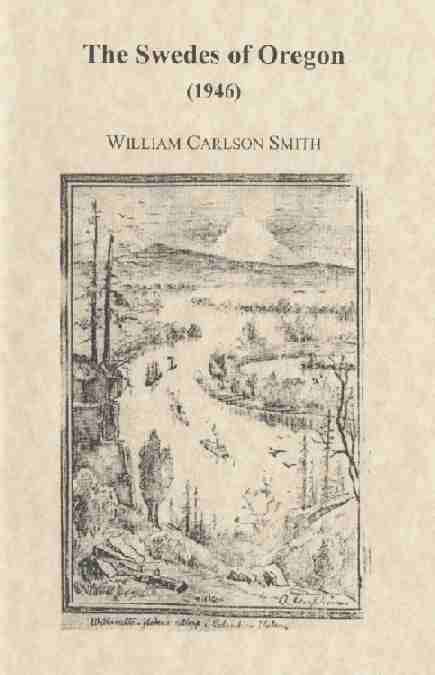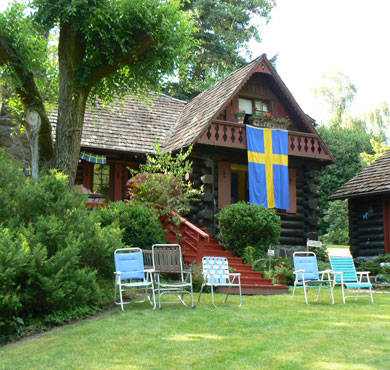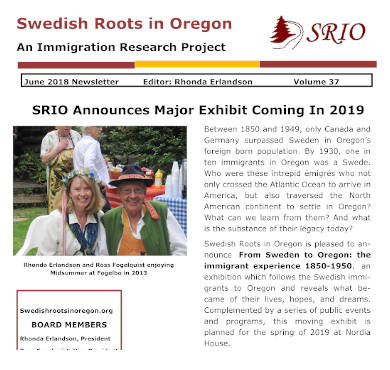This article was originally published by the American Swedish Historical Museum in Philadelphia in its Year Book for 1946. The author, William Carlson Smith, Ph.D., was then a professor of sociology at Linfield College, in McMinnville, Oregon. He was born of Swedish immigrant parents in Minnesota and spent his early years on a farm in a Swedish community at Oakland, Nebraska.
Introduction to The Swedes of Oregon
The following article was originally published by the American Swedish Historical Museum in Philadelphia in its Year Book for 1946. The author, William Carlson Smith, Ph.D., was then a professor of sociology at Linfield College, in McMinnville, Oregon. He was born of Swedish immigrant parents in Minnesota and spent his early years on a farm in a Swedish community at Oakland, Nebraska. He was the author of several books, among them Americans in Process: A Study of our American Citizens of Oriental Ancestry” (1937), Americans in the Making: the Natural History of the Assimilation of Immigrants (1939), and The Stepchild (1953), as well as a number of articles in various sociological journals.
In many ways William Carlson Smith’s article is an extension of the pioneering writing on the Swedish community in Oregon done by Ernst Skarstedt almost forty years earlier. It covers much of the same territory—tells the history of the Swedish churches, organizations, newspapers, and provides cameo biographies of prominent Swedes in the state—but it also includes a great deal of new information which Skarstedt never touched. As a trained sociologist, William Carlson Smith knows how to extract interesting facts from various official records like the United States Census Reports or state voter registration cards. He also quotes extensively from the Oregon press, both American newspapers like The Oregonian and The Oregon Journal, as well as from the Swedish Portland weekly Oregon Posten.
But the most conspicuous difference between Skarstedt and Smith is the difference of perspective. Skarstedt wrote at a time when there was still a continuous influx of new Swedes to Oregon, but by 1946 the facts clearly showed that the peak of immigration had passed, that the number of first generation Swedes was shrinking, that the second and third generation Swedes were assimilating rapidly into American culture, and that Swedish was in the process of disappearing as the primary language in both churches, organizations, and even in the Swedish newspapers. And last but not least, this article also makes it perfectly clear that during the forty years of substantial Swedish immigration to Oregon, the Swedes played an important role in the early development of the state.

Excerpt from The Swedes of Oregon
Immigration to Oregon had two peaks–1880-’90, when a total of 142,936 arrived, and 1900–’10, when newcomers numbered 259,229. The first increase was due largely to the completion of a transcontinental railway line to Portland in 1883. The second influx was, in the main, the result of the Lewis and Clark Exposition held in Portland in 1905, which brought throngs of visitors, many of whom remained or returned later to the state to live. The development of irrigation projects which opened new lands for settlement and the modern exploitation of the great forest resources with the attendant stimulus to all forms of business were attractive forces. In this westward movement of population the Swedes furnished a generous quota. Although the great majority of the Swedes did not arrive in the Pacific Northwest until the late eighties, 205 had made the overland trek by 1870 and by 1880 they numbered 893. The establishment of transcontinental railway travel brought an upsurge to 3,774 by 1890.
For many years Oregon had a State Commission of Immigration which advertised in the eastern states and abroad for immigrants. The Commission made arrangements with an Atlantic steamship company to carry immigrants from Europe at one-half the usual fares. This advertising campaign brought many from New England, the Middle West, and from Europe. The report for 1887 stated that “the Germans and Scandinavians make up the best of the foreign-born immigration”. In 1913 the Commission prepared literature in the Scandinavian languages to appeal to farmers in other parts of the United States who might be interested in making changes because of climatic or other conditions. Oregon Posten also did much to make Oregon known to Swedes in other parts of the country. One man wrote to the editor that while in Canada he had read about the conditions in western Oregon which were so far superior to those of his cold clime that he came. He was so pleased with the change that he wrote that there were several farms near the Baptist Church available for Swedes.
In the Swedish settlement of Oregon, direct migration from Sweden was not the rule. An examination of 193 obituaries and biographies shows that 53 came directly while 140 had resided for longer or shorter periods in the East or Middle West before going to Oregon. The majority came from the middle states. Helge Nelson’s study arrives at the same conclusion, except for a number of sailors who came to the seaports and were laid off there or deserted their ships to go fortune-hunting on land.
This pause of longer or shorter duration on the westward journey influenced the pattern of settlement. The immigrants did not come in groups and settle in colonies, but they came for the most part as individuals and families. Because of the breaks in the movement to the West, the Swedish immigrants had opportunities to become more or less Americanized and consequently they were less prone to segregate themselves in Swedish colonies than those who took up their abodes east of the Rockies.
According to Rosenquist’s researches, more than two-thirds of the immigrants to Texas came from a single province, Jönköpings län. Furthermore, one single parish, Barkeryd, supplied more than one-sixth of the total number for the province. No such concentration is evident in the migration to Oregon. A study of 301 biographical sketches and obituaries indicate that emigration was well scattered–from Lappland in the north to Malmö in the southern tip of the peninsula, and also from Finland. The large majority came from the southern provinces, but they are most densely populated. In the sample, Värmland has the largest number, but several other areas are not far behind.
[i] Reports of the State Commission of Immigration for 1876, 1887, 1914.
[iiI] Oregon Posten, August 21, 1918.
[iii] Helge Nelson, The Swedes and the Swedish Settlements in North America, Lund, 1943, Vol. I, p. 329; Oregon Posten, April 11, 1917, p.3, also substantiates this position.
[iv] Cf. H. Nelson, op. cit., p. 323.
[v] American Swedish Historical Museum Yearbook 1945, pp. 19-22.
[vi] The majority of these obituaries were published in Oregon Posten in the three-year period 1917-’19. In this period a large percentage of the obituaries recorded the deaths of old settlers.





